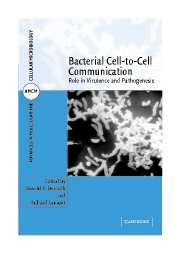Book contents
- Frontmatter
- Contents
- List of Contributors
- Preface
- 1 Quorum sensing and regulation of Pseudomonas aeruginosa infections
- 2 The Pseudomonas aeruginosa quinolone signal
- 3 Quorum-sensing-mediated regulation of plant–bacteria interactions and Agrobacterium tumefaciens virulence
- 4 Jamming bacterial communications: new strategies to combat bacterial infections and the development of biofilms
- 5 Quorum-sensing-mediated regulation of biofilm growth and virulence of Vibrio cholerae
- 6 LuxS in cellular metabolism and cell-to-cell signaling
- 7 LuxS-dependent regulation of Escherichia coli virulence
- 8 Quorum sensing and cell-to-cell communication in the dental biofilm
- 9 Quorum-sensing-dependent regulation of staphylococcal virulence and biofilm development
- 10 Cell-density-dependent regulation of streptococcal competence
- 11 Signaling by a cell-surface-associated signal during fruiting-body morphogenesis in Myxococcus xanthus
- Index
- Plate Section
- References
7 - LuxS-dependent regulation of Escherichia coli virulence
Published online by Cambridge University Press: 08 August 2009
- Frontmatter
- Contents
- List of Contributors
- Preface
- 1 Quorum sensing and regulation of Pseudomonas aeruginosa infections
- 2 The Pseudomonas aeruginosa quinolone signal
- 3 Quorum-sensing-mediated regulation of plant–bacteria interactions and Agrobacterium tumefaciens virulence
- 4 Jamming bacterial communications: new strategies to combat bacterial infections and the development of biofilms
- 5 Quorum-sensing-mediated regulation of biofilm growth and virulence of Vibrio cholerae
- 6 LuxS in cellular metabolism and cell-to-cell signaling
- 7 LuxS-dependent regulation of Escherichia coli virulence
- 8 Quorum sensing and cell-to-cell communication in the dental biofilm
- 9 Quorum-sensing-dependent regulation of staphylococcal virulence and biofilm development
- 10 Cell-density-dependent regulation of streptococcal competence
- 11 Signaling by a cell-surface-associated signal during fruiting-body morphogenesis in Myxococcus xanthus
- Index
- Plate Section
- References
Summary
INTRODUCTION
Escherichia coli is the most abundant facultative anaerobe found in the human intestinal microbial flora. This organism resides in the mucus layer of the mammalian colon, and typically colonizes the gastrointestinal tract of humans a few hours after birth. However, there are several clones of E. coli that have acquired virulence traits that allow them to cause a broad spectrum of disease. These virulence traits are usually encoded within mobile genetic elements, such as plasmids and pathogenicity islands, that have evolved to be stable within these clones. Three general clinical syndromes result from the infection with these pathotypes: diarrheal disease, urinary tract infections, and meningitis/sepsis. Among the intestinal pathogens there are six well-described categories: enterohemorrhagic E. coli (EHEC), enteropathogenic E. coli (EPEC), enterotoxigenic E. coli (ETEC), enteroaggregative E. coli (EAEC), enteroinvasive E. coli (EIEC), and diffusely adherent E. coli (DAEC) (59). This chapter will focus primarily on EHEC and EPEC, given that quorum sensing has been mostly described within these pathotypes.
ENTEROHEMORRHAGIC E. COLI (EHEC)
Enterohemorrhagic E. coli (EHEC) O157:H7 is responsible for major outbreaks of bloody diarrhea and hemolytic uremic syndrome (HUS) throughout the world. EHEC causes an estimated 73,000 illnesses, 2,000 hospitalizations, and 60 deaths in the United States alone each year. EHEC has a very low infectious dose (as few as 50 cfu); this is one of the major contributing factors to EHEC outbreaks.
- Type
- Chapter
- Information
- Bacterial Cell-to-Cell CommunicationRole in Virulence and Pathogenesis, pp. 151 - 174Publisher: Cambridge University PressPrint publication year: 2006



